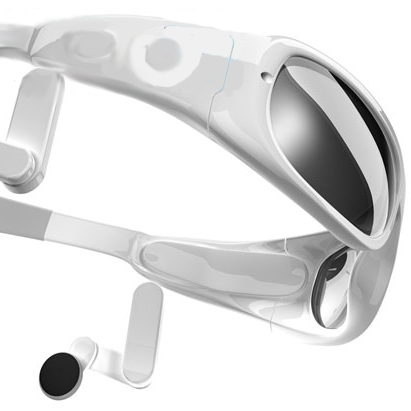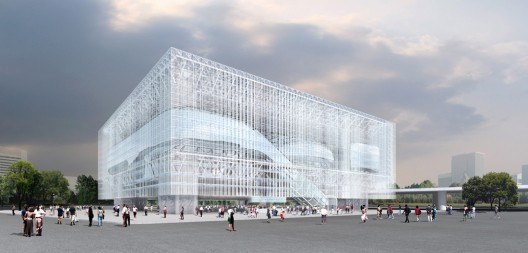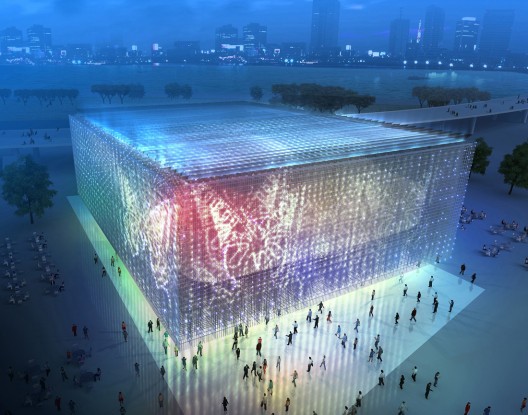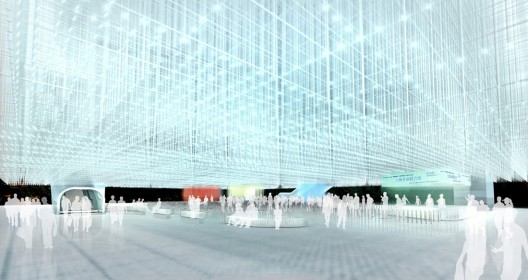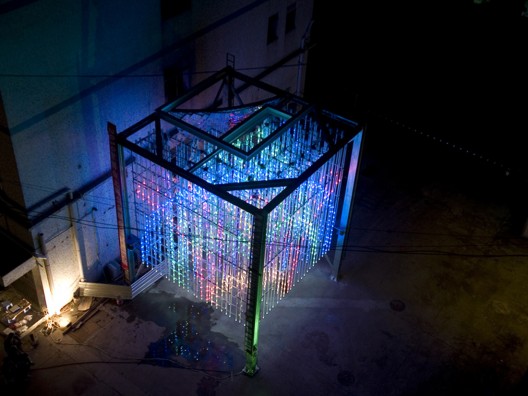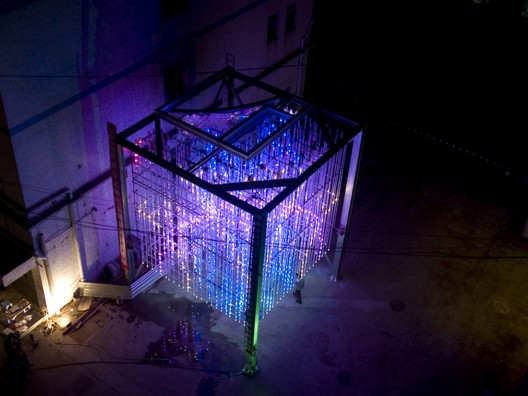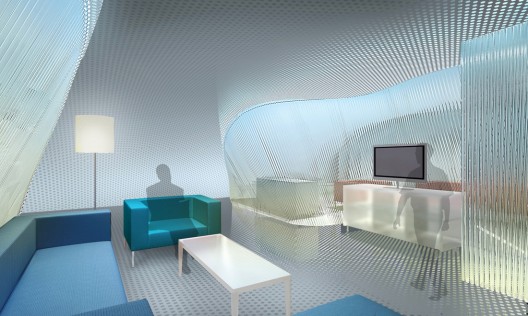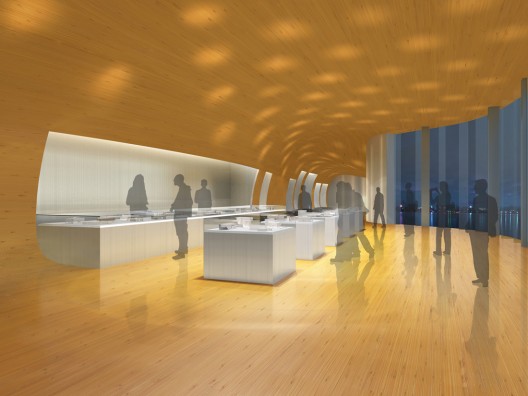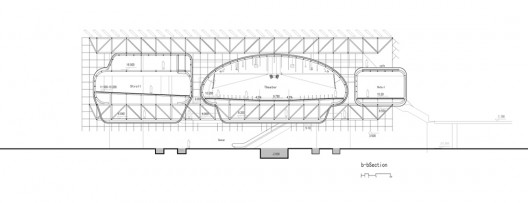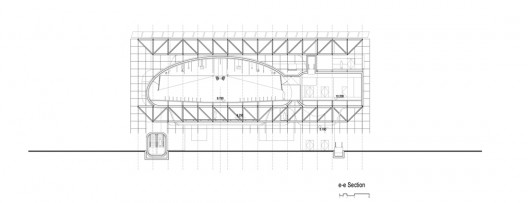Tuesday, February 23. 2010
Screens in Space
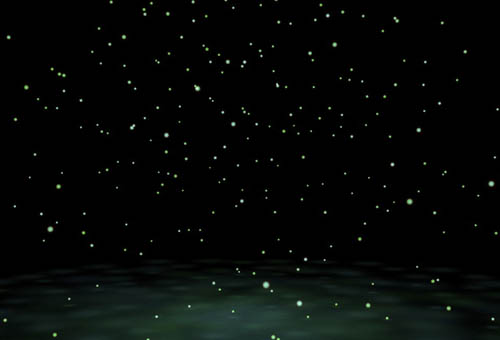 [Image: Via Flyfire].
[Image: Via Flyfire].Each helicopter is "a smart pixel," we read. "Through precisely controlled movements, the helicopters perform elaborate and synchronized motions and form an elastic display surface for any desired scenario." Emergency streetlights, future TV, avant-garde rural entertainment, and even acts of war.
Watch the video:
Instead of a drive-in cinema, in other words, you could simply be looking out from the windscreen of your car at a massive cloud of color-coordinated, precision-timed, drone micro-helicopters, each the size and function of a pixel. Imagine planetarium shows with this thing!
- The Flyfire canvas can transform itself from one shape to another or morph a two-dimensional photographic image into an articulated shape. The pixels are physically engaged in transitioning images from one state to another, which allows the Flyfire canvas to demonstrate a spatially animated viewing experience.
Channeling Tim Maly, we might even someday see a drone-swarm of LED-augmented, artificially intelligent nano-helicopters flying off into the desert skies of the American southwest, on cinematic migration routes blurring overhead. On a lonely car drive through northern Arizona when a film-cloud flies by...
An insane emperor entertains himself watching precision-controlled image-clouds, some of which are distant satellites falling synchronized through space.
-----
Via BLDGBLOG
Personal comment:
D'une façon différente (écran, images volumiques et donc display), cela me fait penser au projet de Nicolas Reeves ("Mescarillons", self assembling architecture) et à ce que nous imaginions au début du projet de recherche Variable_Environment autour de la création d'architectures variables exploitant des "swarm intelligent flying robots"... Impossible à l'époque.
Monday, February 01. 2010
Roll-to-Roll Printed Plastic Displays
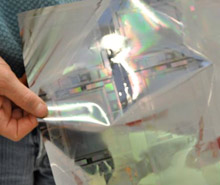 |
| Print out: This plastic material is used as the backing for Phicot's amorphous silicon electronics. Credit: Phicot |
Now a company called Phicot has adapted a technique for printing
"The basic technology of roll-to-roll can bring the price down and make plastic an excellent option for the back half of the display," says Frank Jeffrey, cofounder and CEO of PowerFilm.
Most modern displays rely on transistors made of polysilicon--a semiconductor that allows electrons to move fast enough for video. The problem with polysilicon is that it needs to be deposited at high temperatures that melt plastic. So Phicot turned to amorphous silicon, which can be deposited at low temperatures and yet is still fast enough to control the pixels of electrophoretic displays such as E-Ink, and eventually those in an organic light-emitting diode (OLED) display.
At Phicot's facility, layers of amorphous silicon and insulating materials are deposited onto plastic. These rolls of plastic are then sent to a facility at HP Labs, where engineers use a novel kind of lithography, called self-aligned imprint lithography (SAIL), to etch transistors onto the plastic's surface.
Once the transistors have been deposited, the screen itself must be added. HP has tested its transistors using E-Ink and with its own reflective display technology, capable of showing color and video. According to Carl Taussig, director of HP's information surfaces labs, the amorphous silicon transistors could, with slight changes to their chemical makeup, also drive OLEDs.
Phicot isn't the only company trying to make plastic-based displays. Polymer Vision, a spin-off of Philips, and
Another advantage of amorphous silicon over organic materials is that its electronic performance is well known. "Organics are less well developed," says John Rogers, professor of
The transition from thin-film solar to printing display transistors was relatively simple, says PowerFilm's Jeffrey. The major difference is that the layers are deposited in a different order. Some layers also need to be doped--adding impurities to change a layer's electrical properties--in a different way. "We used our solar-cell machines to do the first development work," he says. "It was very straightforward."
Phicot is planning to move to a facility in
But the process is far from perfect. Jeffrey says that the engineers are quickly solving many of the defect challenges--the major obstacle to mass production at this point. For instance, the process must be fine-tuned so that the plastic isn't stressed in a way that could, down the line, result in defective circuitry.
Another challenge is making sure that the plastic is as defect-free as possible to start with. "Your plastic has to be smooth," says Alberto Salleo, professor of materials science and engineering at Stanford. "And as it goes through the rolls it shouldn't expand or crack."
Jeffrey says there may be ways to adapt the electronics to flaws in the plastic. "We have a possible option of designing our circuitry to tolerate those" he says.
Copyright
-----
Related Links:
Friday, January 29. 2010
iGlasses Coming?
In a week when we are all learning to say iPad, we might also start practicing 'iGlasses'. Apple's got patents on augmented reality goggles:
- Apple See-Through Augmented Reality HMD Glasses
The January issue of Mac Life sports a fauxtograph of possible Apple augmented reality HMD glasses. It’s hard to know how much of this article is based on concept, but Apple working on an AR HMD would be a huge jumpstart to the nascent technology.
In mid-April of 2008, Apple published a patent for a “Head Mounted Display System.” The patent shows screens and fiber optics and vision imaging controls. Would the display use pico projection or utilize OLED displays? Pico displays could be used right now, but OLEDs might be a year out.
Would Apple make HMD goggle for augmented reality? Looking back at this 2006 interview on MacSimumNews, we can see that Steve Jobs was already considering it. Given that he also denies Apple is looking at a HMD practically guarantees they have something in the works.
Jobs: Yes, you want a nice big screen so that you can see lots of music and you can pick out what you want, versus a tiny little screen. But then again, you want the screen to be small so that you can put it in your pocket. Actually, discovering and buying music on a computer and downloading it to the iPod—in our opinion, that’s one of the geniuses of the iPod. So you can look at changing that—and maybe that will happen over time—but I think the experience you’ll get on a device optimized for putting in your pocket is going to be far less satisfactory than on a personal computer. You may still want to do that [on a small screen] occasionally, but I don’t think it’s ever going to mean that you can not have some other device that is your primary device for buying and cataloguing music.
Swisher: What would solve that? Can it be solved?
Jobs: Rollable screens, goggles you can put on; I don’t know. It’s not on the horizon.
Goggles you can put on, indeed.
-----
Via /Message
Personal comment:
Il faut battre le fer pendant qu'il est chaud... Pour contribuer à lancer la prochaine rumeur Apple...
Thursday, January 07. 2010
Light Touch projection technology turns any flat surface into a touchscreen
We’ve seen virtual keyboards before, but the technology has never quite taken off. But this is quite exceptional. UK-based Light Blue Optics (LBO) has unveiled a revolutionary compact projector that lets users interact with images projected onto a flat surface, essentially turning it into a touch screen. Remarkably, it has built-in Wi-Fi and Bluetooth connectivity, which allows users to access and connect with internet-based applications and engage in social networking and multimedia sharing via the projector itself, which runs Adobe Flash Lite 3.1. The Light Touch projector transforms the usually static image created by a projector into interactive multimedia content using Light Blue Optics’ proprietary holographic laser projection technology. The device can project a virtual 10-inch interactive display onto any surface and the integrated infra-red touch sensing system enables users to interact with the virtual image in the same way they would use a handheld touchscreen device. The device is set to be showcased in an invite-only event on Thursday, January 7th at CES. LBO also announced a list of global companies working with the Company to bring its unique projection technology to market; Adobe, CSR, Foxconn, Interbrand, Microsoft, Micron, Nichia, Photop, Opnext and Toshiba. It comes equipped with 2GB of onboard Flash memory and has a Micro SD card slot for up to 32GB of storage, running wall-powered or battery-operated, with a run-time of two hours before recharging is required. The Light Touch certainly looks very interesting, but there are no details on pricing or availability yet.![Light Touch projection technology turns any flat surface into a touchscreen [Video] Light Touch Interactive Projector 11 540x377](http://blog.fabric.ch/fabric/images/1205_1262901603_0.jpg)
Tuesday, December 22. 2009
Sony and RealD team for 3D at home
The best news I have heard this week was that the specs for 3D Blu-ray were finalized and that the PS3 would support 3D. That means with a simple firmware update PS3 owners will be able to enjoy 3D movies assuming they have a compatible TV. Sounds like it’s time for me to upgrade! Sony also announced this week that it has teamed up with RealD to bring 3D technology to the home. You might recognize the RealD name as the company who is behind the 3D technology for many of the high-end 3D films in theaters like Avatar and others. Odds are if you watched a 3D movie in the theater lately, RealD was the tech behind the cool movie. Sony will be licensing RealD tech for use in consumer products in 2010, including the stereoscopic 3D tech behind RealD in theaters. The tech will go into 3D Bravia LCD TVs and 3D eyewear needed to view the content.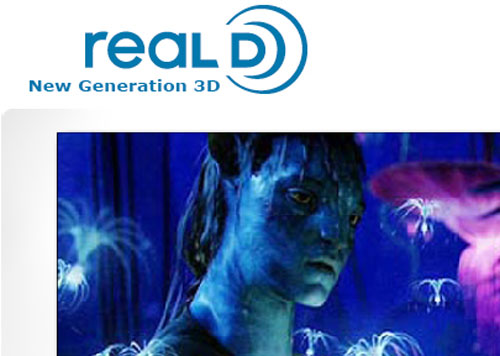
Personal comment:
la 3D pour les films pousse, mais cela n'enlève rien au coté gadget de la chose. L'énergie investie dans cette technologie est également biaisée/boostée par le fait que c'est également un moyen de lutte contre les copies illégales de film... propose-t-on de la 3D parce que cela apporte qqchose, ou bien propose-t-on la 3D pour éviter ou rendre bien plus difficile la copie du contenu... Le fait que tout cela soit toujours "restitué" par l'intermédiaire d'un écran (plat) me fait penser que nous sommes encore bien loin d'une véritable restitution volumétrique de l'enregistrement d'une scène passée.
Friday, December 04. 2009
Opto-electronic contact lenses promise wireless displays
The opportunity to jab yourself in the eye with a tiny computer display is one step closer, thanks to the ongoing work with opto-electronic contact lenses taking place at the University of Washington in Seattle. The lab there has been showing off the latest prototype, the handiwork of Dr. Babak Parviz: a semi-transparent array – including an LED – embedded into a lens that receives 330 microwatts of power wirelessly from a nearby RF transmitter. Parviz has been using the prototypes to display biosensor feedback about the wearer’s vital signs, but they’ll eventually serve as a heads-up display for displaying other data. The wireless power is picked up by a loop antenna built into the lens, and future iterations of the hardware are expected to integrate the transmitter into a cellphone. There’ll also be far many more LEDs involved, so that the resolution is high enough to be useful. “Conventional contact lenses are polymers formed in specific shapes to correct faulty vision. To turn such a lens into a functional system, we integrate control circuits, communication circuits, and miniature antennas into the lens using custom-built optoelectronic components. Those components will eventually include hundreds of LEDs, which will form images in front of the eye, such as words, charts, and photographs. Much of the hardware is semitransparent so that wearers can navigate their surroundings without crashing into them or becoming disoriented” Dr Parviz, University of Washington in Seattle Future plans see the opto-electronic lenses being used for more than just displaying data; they’ll also be able to monitor the eye’s surface chemistry, which would allow wearable computers to keep track on blood sugar levels in diabetics and other information. Parviz’s eventual goal is the contact lens becoming a platform “like the iPhone is today”, with developers creating custom apps. However it seems that’s a reasonably long way off into the distance.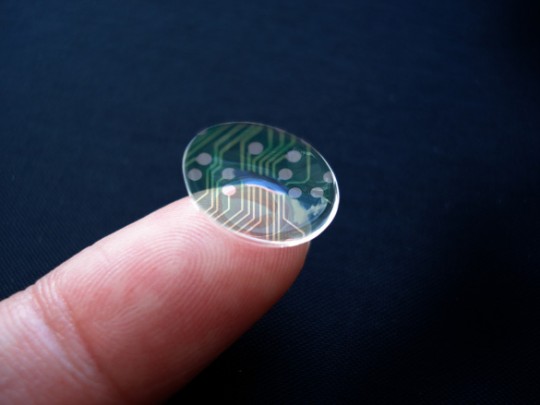
Via Slashdot
Tuesday, October 20. 2009
Sony's 360-degree 3D display prototype

In case you missed it, Sony's got a thing for 3D with big plans to push the technology into your living room next year. While the first application will be applied to the flat screen TV, Sony's obviously thinking about other displays judging by this tiny prototype set for reveal at Tokyo's Digital Content EXP0 2009 on Thursday. The 13 x 27-cm device packs a stereoscopic, 24-bit color image measuring just 96 × 128 pixels viewable at 360-degrees without special glasses. If the prototype ever hits the assembly line then Sony envisions its commercial use in digital signage or medical imaging -- or as a 3D photo frame, television, house for your virtual pet, or visualizer to assist with web shopping in the home. We'll be on-hand for the unveil on Thursday with live coverage and hands-on, check back then for more.
Via Engadget
Monday, September 28. 2009
Animated Facade :The Non-Existence of Architecture
I found this video on the web today.
AEC Facade Visualization from Claus Helfenschneider on Vimeo.
The digital work and art is fascinating. This level of digital media integration at the urban scale has been floating around architectural circles since the 1970s. The problem as I see it, is seeing such measures are achieved now, the architecture is completely destroyed. The avatar is shrouded by a cheap veil of blinking and pulsing lights which will become kitsch far too easily.
Claus' work here is nice, but I am worried about the greater damage which architecture will suffer if we keep practicing such masochism regarding the product.
Personal comment:
I quite agree with Mr. Jargon! That's the least I can say even if we just collaborated with a media facades company. Hopefully for a more architectural result! (if it gets built... ;))
Tuesday, September 01. 2009
The Shanghai Corporate Pavillion for World Expo 2010 / Atelier Feichang Jianzhu
In the past months we’ve been featuring several pavillions from the countries participating in the Shanghai World Expo 2010 (and many more to come). Today, we bring you the Shanghai Corporate Pavillion, designed by Atelier Feichang Jianzhu. More images and full architect’s description, after the break.
In 1976, Centre Pompidou in Paris, designed by Renzo Piano and Richard Rogers, turned the building inside out and made utility ductworks part of the architectural expression. It was unprecedented thus a breakthrough in the field of architecture.
In 2010, we will have gone through a long period of rapid technological advancement and the amount of infrastructure in a building will have dramatically increased to the point that technologies are today’s basic building blocks. For Shanghai Corporate Pavilion at the World Expo, we would like to manifest this observation in our design: the interior spaces of the Shanghai Corporate Pavilion, which are shaped as a series of free, flowing forms, will be no longer enclosed by walls of the static kind but a dense, cubic volume of infrastructural network, including LED lights and mist making system, which are capable of changing the appearance of the building from one moment to another as programmed through computer.
However, our design is not embracing technology for the technology’s sake. Rather, we like to convey visually the spirit of the Shanghai Corporate Pavilion, the dream of a brighter future, through sophisticated technologies. Technology is about the enrichment of imagination and symbolic of the industry and industrialism of Shanghai. Also through technology, we like to address the pressing issue of energy and sustainability. A part of the architectural infrastructure is designated for the solar energy harvesting and rain water collecting,and the external facade will be made of recycled plastic
World Expo is always a window to the future. Shanghai, as a historically progressive yet still fast developing international metropolis, has been all along the embodiment of this forward looking optimism. As architects, we take the special occasion offered by the World Expo 2010 to solute Shanghai, a great city of the 21st Century, through our architectural design.
Technological Detail and Environmental Protection
1. Solar Energy System
The Shanghai Corporate Pavilion features a 1600m2 solar heat-collecting tube on the roof. These solar tube can collect solar energy to produce hot water up to 95°C. Ultra-low temperature power generation techology, a novel way to generate electricity through solar power. The power generated using this technology can be used for both the exposition and for every day.
2. Recycled Plastic materials
Shanghai produces nearly 30 million of waste CDs every year, and only 25% of them are reclaimed and recycled. If these CDs were reclaimed and washed, they could be used to produce polycarbonate granules and manufacture more polycarbonate plastic products. The external facade materials of the Shanghai Corporate Pavilion will use polycarbonate transparent plastic tubes to create its dreamlike appearance. After the Expo, also plastic tubes can be easily recycled to reduce social wastage.
3. Water/mist System
For the Shanghai Corporate pavilion, rainwater will be collected and recycled. After such treatment as sedimentation, filtration and storage, rainwater can be used for daily purposes at the pavilion and for the “mist” in particular. The mist can lower the temperature, purify the air and create a comfortable climate in pavilion. The spray can also be used to form various patterns under ceiling of entrance hall and make the overall appearance of the Shanghai Corporate Pavilion fresh and elegant
Client: SHANGHAI GUOSHENG GROUP CO., LTD.
Pricinples: Yung Ho CHANG
Project Architect: Zang Feng
Project Team: Wang Siuming, Liu Lubin, Wang kuan, James Shen,Qiu Yukui, Liang Xiaoning, Wang Lin, Wu Xia, Zhang Minghui, Wu Jie, Chen Guannan, Tang Hung Fai
Consultants: Center for Engineering Design and Research under the Headquarters of General Equipment
Structure and Material: Steel
Building Area: 4949 sq. meters
Design Period: 2008-2009
Construction Period: 2009-2010
Click here to view the embedded video.
Via ArchDaily
Personal comment:
Des volumes noyés dans une espèce d'écran volumique composé de pixels (qui n'est pas sans rappeler des choses déjà vues pour l'écran, mais en bcp bcp plus petit... Choses qui elles même nous ont souvent fait penser à la matrice de Knowscape). Il y a même du "moisturizer", mais malgré tout, le projet ne fait pas très envie... Pourquoi?
Friday, June 05. 2009
The Display That Watches You
-
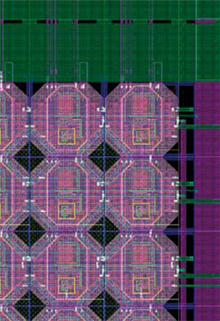 |
| Two-way display: This image shows a detailed layout of the Fraunhofer display chip, which combines photodetectors with an organic light-emitting diode display. Credit: Fraunhofer Institute for Photonic Microsystems |
Researchers at Fraunhofer Institute for Photonic Microsystems (IPMS) have now developed a screen technology that could help make wearable displays more compact and simpler to use. By interlacing photodetector cells--similar to those used to capture light in a camera--with display pixels, the researchers have built a system that can display a moving image while also detecting movement directly in front of it. Tracking a person's eye movements while she looks at the screen could allow for eye-tracking control: instead of using hand controls or another form of input, a user could flip through menu options on a screen by looking at the right part of the screen. The researchers envisage eventually integrating the screen with an augmented-reality system.
"We can present an image and, at the same time, track the movement of the user's eye," says Michael Scholles, business unit manager at Fraunhofer's IPMS. "This is of great interest for all kinds of applications where your hands are needed for something else, like a pilot flying an aircraft or a surgeon wanting to access vital parameters while performing a surgery."
Eye-tracking technology is nothing new, of course. Over the years, researchers have developed a number of systems that follow a person's gaze to allow him or her to interface with a computer. Often, the applications are for physically impaired people, but they can also be designed for a general computer user.
Additionally, researchers have been developing wearable display systems for years, but for the most part, these have been clunky, power hungry, and not entirely practical to use, says Alexander Sawchuck, a professor of electrical engineering at the University of Southern California. "Anything that can be done to make [wearable displays] more compact or lighter weight and low power is important," he says. And integrating a display and a camera on one chip is a step toward this, he says.
The researchers built the system by first designing a light-sensing chip, which features a pattern of evenly spaced photodetectors. This was then fabricated at a commercial semiconductor manufacturing facility. A wafer containing multiple chips was then placed in a deposition chamber, where layers of organic material were deposited in between the photodetectors. These layers make up the organic light-emitting diodes, or OLEDs, that create the display. The mosaic of photodetectors and OLEDs is then encapsulated in a thin polymer film to protect it.
The idea of integrating OLEDs with a photodetector chip is intriguing, says Sawchuck. "There are a lot of challenges in building wearable displays for the applications [intended by the researchers], and any advances in this field are very exciting," he says.
The Fraunhofer IPMS researchers will demonstrate their prototype at the Society for Information Display conference in San Antonio this week. The current version touts a simple monochromatic display--about 1.25 centimeters on each side, with a resolution of 320 by 240 pixels. Scholles says that full-color displays are possible but trickier to create because they require adding color filters to white OLEDs, which are difficult to make efficiently and aren't always reliable. However, the team at Fraunhofer IPMS has partnered with Novaled, an OLED company that manufactures high-quality white diodes, and plans to make future color prototypes using the company's diodes.
The camera in the researchers' current prototype is still fairly rudimentary. It has a resolution of only 12 pixels, which means that it can't yet track a user's eye movements. However, Scholles says that the team has developed a 160-by-120-resolution version of the camera chip that has been tested in the lab, but not yet integrated with a display. The researchers expect to have an advanced version of the system, complete with higher-resolution camera and full eye-tracking capability, by early 2011.
Copyright Technology Review 2009.
-----
Personal comment:
Des display qui "surveillent" si on les regarde, qui peut-être développeront le tracking de la rétine, par défaut. Pas très bon pour la privacité, mais un rêve pour les publicistes! ...
fabric | rblg
This blog is the survey website of fabric | ch - studio for architecture, interaction and research.
We curate and reblog articles, researches, writings, exhibitions and projects that we notice and find interesting during our everyday practice and readings.
Most articles concern the intertwined fields of architecture, territory, art, interaction design, thinking and science. From time to time, we also publish documentation about our own work and research, immersed among these related resources and inspirations.
This website is used by fabric | ch as archive, references and resources. It is shared with all those interested in the same topics as we are, in the hope that they will also find valuable references and content in it.
Quicksearch
Categories
Calendar
|
|
July '25 | |||||
| Mon | Tue | Wed | Thu | Fri | Sat | Sun |
| 1 | 2 | 3 | 4 | 5 | 6 | |
| 7 | 8 | 9 | 10 | 11 | 12 | 13 |
| 14 | 15 | 16 | 17 | 18 | 19 | 20 |
| 21 | 22 | 23 | 24 | 25 | 26 | 27 |
| 28 | 29 | 30 | 31 | |||
